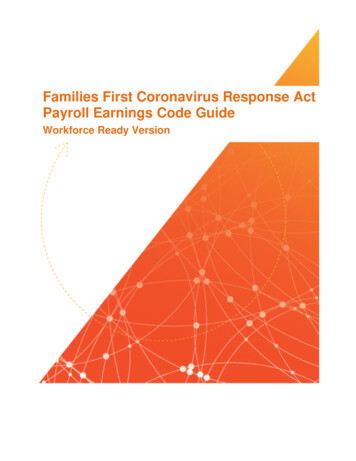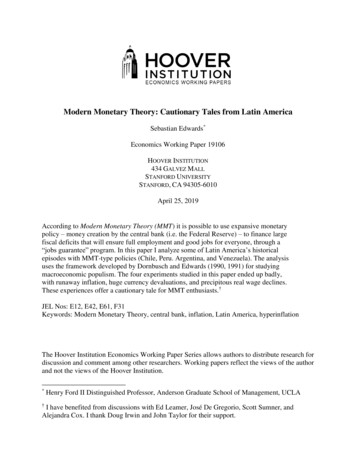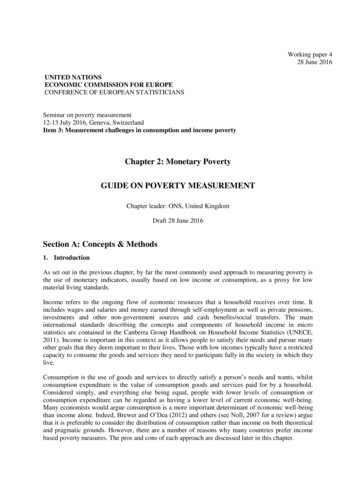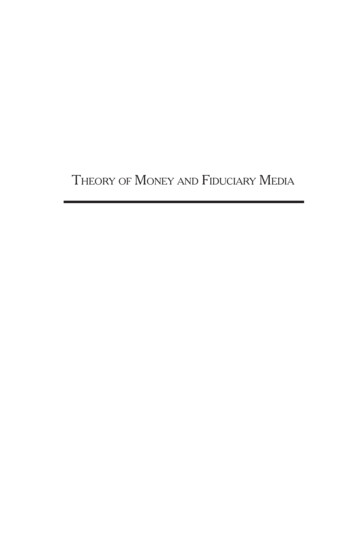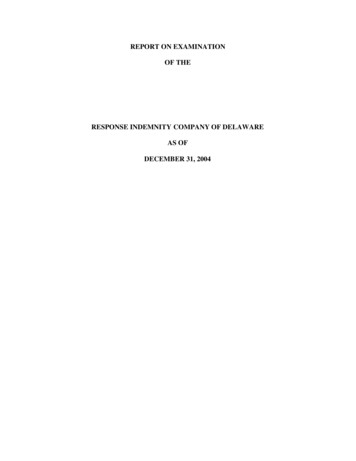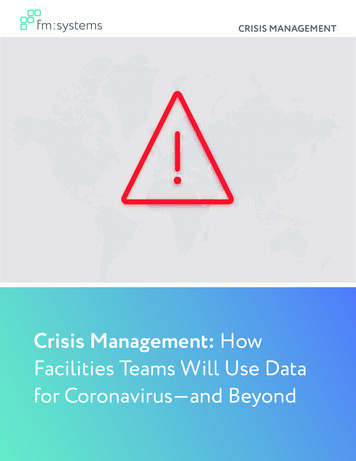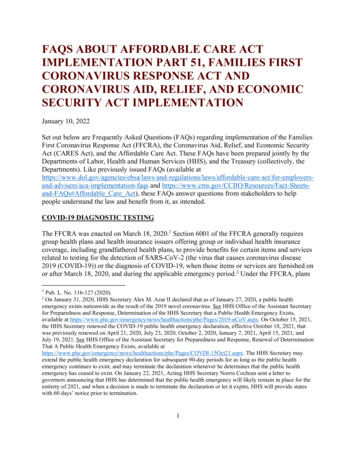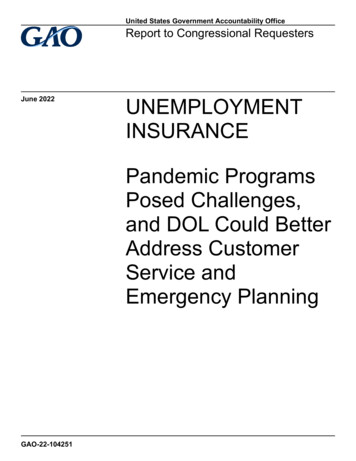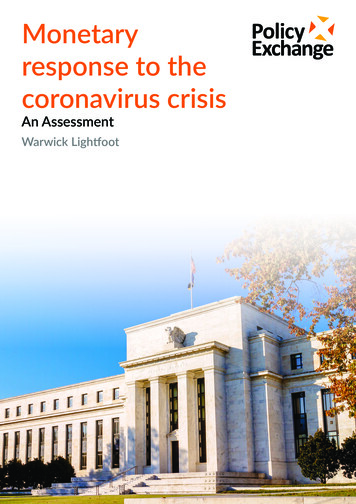
Transcription
Monetaryresponse to thecoronavirus crisisAn AssessmentWarwick Lightfoot
Monetary response to thecoronavirus crisisAn AssessmentWarwick LightfootPolicy Exchange is the UK’s leading think tank. We are an independent, non-partisan educational charity whose mission is to developand promote new policy ideas that will deliver better public services, a stronger society and a more dynamic economy.Policy Exchange is committed to an evidence-based approach to policy development and retains copyright and full editorial controlover all its written research. We work in partnership with academics and other experts and commission major studies involvingthorough empirical research of alternative policy outcomes. We believe that the policy experience of other countries offers importantlessons for government in the UK. We also believe that government has much to learn from business and the voluntary sector.Registered charity no: 1096300.TrusteesDiana Berry, Alexander Downer, Pamela Dow, Andrew Feldman, David Harding, Patricia Hodgson, Greta Jones, Edward Lee, CharlotteMetcalf, David Ord, Roger Orf, Andrew Roberts, George Robinson, Robert Rosenkranz, William Salomon, Peter Wall, Simon Wolfson,Nigel Wright.
Monetary response to the coronavirus crisisAbout the AuthorWarwick Lightfoot is Head of Economics and Social Policy at PolicyExchange. He is an economist, with specialist interests in monetaryeconomics, labour markets, and public finance. He has served as SpecialAdviser to three Chancellors of the Exchequer, and a Secretary of Statefor Employment. Warwick was a treasury economist at the Royal Bankof Scotland, and has also been Economics Editor of The European. Hismany articles on economics and public policy have appeared in the WallStreet Journal, the Financial Times, The Times, The Sunday Times, theDaily Telegraph, the Sunday Telegraph, and in specialist journals rangingfrom the Times Literary Supplement and The Spectator, to the InvestorsChronicle and Financial World. His books include Sorry We Have NoMoney — Britain’s Economic Problem.2 policyexchange.org.uk
Policy Exchange 2020Published byPolicy Exchange, 8 – 10 Great George Street, Westminster, London SW1P 3AEwww.policyexchange.org.ukISBN: 978-1-913459-44-4policyexchange.org.uk 3
Monetary response to the coronavirus crisisContentsAbout the Author 2Summary of Conclusions 5Introduction 8Taking stock of the Covid crisis and the longer-term challenge of becalmedeconomies 9Successfully managing the liquidity crisis in March 9Huge sums raised in private sector markets match theliquidity pumped in by central banks 10‘Zombiefication?’ 12Low inflation and low interest rate expectations appear firmly anchored 13Federal Reserve further refines its inflation target 14The progressive recognition that models and assumptionswhich policy was based on had broken down 15Managing expectations and promising inflation can backfire 16Negative interest rates, the Bank of England andthe effectiveness of monetary policy 17Taking a back seat: monetary policy when it has run out of road 18Fiscal stimulus and micro-economic structural reform 19Central bank economists marking their own homework: too optimistic a glosson recent monetary innovation? 19The fusion of monetary and fiscal policy tools withinmacro-economic policy 20The new normal of very slow growth 21The Demographic Origins of the Startup-Deficit 234 policyexchange.org.uk
The coronavirus crisis – estimated to have caused the sharpest annualcontraction of output for 300 years – has to be viewed against an economicenvironment shaped by the last global economic upheaval: the 2008financial crisis.This environment is distinguished by four features:1. Very low and anchored inflationary expectations2. Historically very low interest rates and government borrowingcosts3. Slow and insipid economic growth accompanied by downwardrevisions to estimated trend rates of growth4. Growing appreciation that advanced economies may have enteredsome form of profound stationary state or secular stagnation – aprolonged period of very low or no growth.This paper focuses on how central banks have responded since March tothe Covid crisis, explores the discrete episodes such as the liquidity crisisin the Spring and the evidence of companies borrowing to accumulatecash and the equity price boom that has followed the huge injections ofliquidity into the international financial system. It offers an impression ofwhere policy makers are and the limits that central banks confront in a lowinterest rate environment where monetary policy has no more space leftand is not effective.Summary of Conclusions There has been a huge monetary response to the economicconsequences of the Covid shock. Central banks have hugelyexpanded their balance sheets. This is a further expansion ofwhat were already hugely expanded central bank balance sheetsfollowing Quantitative Easing (QE) and other unorthodoxmonetary measures following the Great Recession. They have cutinterest rates even lower too and here in the UK, where policyrates are now 0.1% there appears to be an ongoing debate in policycircles as to whether we should move to negative interest rates.These measures and the purchase of assets were led by the FederalReserve and successfully stabilised market liquidity. Financialmarkets, including the US Treasury repo market, exhibited agenuine crisis of liquidity, but the central banks successfullycontained it.The actions of central banks have pumped huge flows of liquidityinto financial markets and that has been reflected in much higherfinancial market asset valuations. This is particularly marked inequity markets as well as the bond and credit markets, where creditspreads have been compressed at a time when corporate earningsand dividends have been cut as the likelihood of insolvency andpolicyexchange.org.uk 5
Monetary response to the coronavirus crisis 6 policyexchange.org.ukbankruptcy has increased.The combination of very low interest rates globally and in theUK and other public sector support has increased the numberof zombie businesses that would normally close but are able tostruggle on, with little scope for innovation and development.Many companies have borrowed in order to hoard cash. This wasa feature of the long and slow recovery from the Great Recessionand is pronounced now. Low interest rates and higher companyborrowing has not been matched by higher investment but varyingforms of financial engineering, leverage and accumulation ofprecautionary balances. The very low rates of interest have furthercompounded the micro-economic problems in credit markets thatwere apparent before the Covid crisis.Monetary policy was already at the limit of what it could achievein terms of stimulating economies in the event of a shock beforethe Covid crisis and its limits remain clear after all the measuresthat have been taken since March. The Bank of England reportedlyconsidering negative interest rates is further indication of thelimits that monetary policy is encountering. Active fiscal policiesto stimulate demand are now the key to macro-economicmanagement. This has been directly recognised by the Chair ofthe Federal Reserve Board Jay Powell and by both his immediatepredecessors, Ben Bernanke and Janet Yellen.Both low inflation and low interest rates are embedded in marketexpectations. Interest rates and bond yields have fallen and thecosts of servicing public sector debt in the US, UK and otheradvanced economies have fallen. In tackling the immediate crisisthis means that policy makers should be less constrained than theywere in the past, when both inflation and interest rates were high.In assessing the scope for discretionary fiscal policy, the internationaleconomic context is just as important as the domestic. Integratedfinancial markets where capital flows freely across borders meanthat, for example, the actions of the Federal Reserve are frequentlymore important to questions of financing UK public debt thanthe actions of the Bank of England, while the capacity of financialmarkets to absorb newly issued UK debt should be viewed in thecontext of international demand for gilts, not just domestic. Inthe first decades of the 21 century there has been a recognitionthat interest rates have converged internationally because of globalinfluences rather than national ones. Last year presentations atthe Jackson Hole conference explored these themes not least inrelation to the central role that the dollar has in payment systems,invoicing and reserve holdings.The debate about raising central banks’ inflation targets is anotherreflection of the ineffectiveness of monetary policy. Given thatcentral banks have not been able to meet their current targets of 2per cent it is not clear how they would hit, say, a 4 per cent target.
Higher expected inflation, moreover, would have different resultsfrom that hoped by policy makers. Businesses and households seeinflation in a negative light - instead of boost to their confidenceabout employment incomes and investment, it could have theopposite effect.The debate about monetary policy and macro-economic demandmanagement is taking place in the context of greater appreciationof much slower rates of trend economic growth. There is increasingevidence that advanced economies may be experiencing the sortof stationary states that classical economists speculated about. Andthe future may reflect the experience of Japan over that last thirtyyears.The explanations for this range from lower productivity growth inincreasingly service based economies include aging demographyand changing market structures. There is much discussion in theUS about increased market concentration, higher monopoly markups and competition policies that may have accommodated this.Much of this is not directly relevant to the UK which was underthe jurisdiction of EU competition policy and improved its owndomestic competition policy. One interesting suggestion is thatgrowth may be slowing because the diffusion of knowledge hasbeen slowed by much more aggressive and significant use of patentsand intellectual property law which impedes the opportunitiesthat firms have from borrowing good practice and innovation thatin the past has had resulted in beneficial spill overs arising fromresearch and development.A lack of demand in the economy and spare capacity should beremedied by macro-economic stimulus. In the context of slowingtrend growth policy makers need to be realistic about the sort ofeconomic growth they may generate. The OECD recognises thelimits of monetary policy and advocates use of fiscal policies andstructural reform to improve growth. In many advanced economiesparticularly in Europe there is clear scope for ambitious structuralreforms to improve the supply performance of the economy. Insome economies such as the Netherlands and the UK there is muchless scope for further structural reform given that so much hasbeen undertaken over the last forty years particularly in relation tolabour markets.The UK should explore opportunities to lock in the presenthistorically very low rates of interest on its public debt by extendingthe maturity and duration of its debt. It can do this by exploringissuing much longer dated fifty- and hundred-year maturity gilts inthe manner that other countries such as Austria have done. Also,it would be beneficial to look again at the appetite internationalinstitutional investors (such as pension funds and insurancecompanies) have for permanent non-repayable undated bondsissued at a slightly higher rate of interest than conventional debt,policyexchange.org.uk 7
Monetary response to the coronavirus crisis such as the so-called ‘Consols’. The Debt Management Office pointout that historically, undated gilts used to comprise the majorityof the UK debt stock prior to the Second World War in 1939.Post-Brexit, the UK’s economic and financial authorities, inparticular the Chancellor of the Exchequer and the Governor of theBank of England, should use the status and history of London as theworld’s first major international financial centre and to positionthe UK as a world leader on financial policymaking, prominenton international stages such as the IMF, Davos and indeed JacksonHole.IntroductionSix months into the shock delivered to the international economy by theCovid virus, this is a good time to take stock of one of the vital shockabsorbers for the global economy – namely the policy response of theworld’s principal central banks and monetary authorities to the crisis. Thisnote reviews the direction policy has taken and how it is perceived bythe principal monetary authorities. It draws on the presentations at theannual Jackson Hole Conference of central bankers as that has continuedto influence the debate, as well as other papers to explore current centralbank thinking and perceptions of the effectiveness of monetary policy asan economic tool. The Jackson Hole event is organised each year by theFederal Reserve Bank of Kansas City, the Quarterly Report published bythe Bank for International Settlement in September 2020 and the reactionto the Federal Reserve Board’s modified approach to its inflation target toassess some of the important issues. These include monetary and financialconditions, the present approach of monetary policy and the effects of themonetary response to the Covid shock in terms of its consequences forinternational liquidity, wider monetary conditions and financial markets,as well as the wider structural economic context that monetary policy isworking in.Normally, the Jackson Hole conference takes place in the beautifulmountain resort that gives the occasion its name. This year, however, it wasa full-scale virtual conference with papers, slides, speeches, presentationsand panels along with questions and a cross-examination of papers froman international audience. It was probably none the worse for its virtualorganisation and an object lesson in how high level and technical publicaffairs can be conducted online, and offers an illustration of the sort ofchange that the response to the virus has generated. The conference itselfexemplified the reallocation effects taking place in the global economythat were under discussion.8 policyexchange.org.uk
Taking stock of the Covid crisis and the longer-termchallenge of becalmed economiesThe economic backdrop to the conference was clear. There has been ahuge reduction in economic activity in the first half of the year as the virusspread. Governments took public health measures to arrest the transmissionof the disease, while households and businesses took measures to protectthemselves from Covid’s perceived dangers. At the start of the crisis, theeconomic shock – as well as being a specific exogenous health shock toeconomies – had the effect of crystallising financial and economic anxietiesthat are inevitably accumulated over a long period of expansion.Among the accumulating financial anxieties that the mature phase ofthe cycle was generating was a concern about liquidity in money andbond markets – in particular, whether there were sufficient players in therepo and swap markets with enough capital committed to their tradingoperations to ensure the proper functioning of securities and creditmarkets in the context of a shock provoking a flight to safety and cash. InMarch of this year, this was swiftly tested, potentially to destruction, notleast in the US Treasury market. There was a flight to quality and cash, andthe only cash that was in demand was dollars. Even advanced economies,whose currencies carried some of the characteristics of a reserve currencyor potential safe haven, such as sterling and the Swiss franc, were affectedby increased demand for the dollar, which is normally only experiencedby emerging economies.Successfully managing the liquidity crisis in MarchThe Federal Reserve Board in Washington responded with massive injectionsof liquidity into both the domestic US markets and into the internationalforeign exchange and securities markets. Policy was constrained by thevery low level of interest rates, but the Federal Reserve expanded itsbalance sheet aggressively and broke new ground in the range of assetsit was prepared to buy, such as municipal bonds to help state and localgovernment authorities in the USA. The Federal Reserve undertook bondpurchase operations equivalent to around two-thirds of the QuantitativeEasing (QE) undertaken between 2009 and 2014. Its balance sheet hasincreased by over two-thirds from 4.15 trillion in March to 7 trillionand looks set to increase further. This lead was followed by the otherprincipal G7 central banks. The European Central Bank (ECB) increasedits asset purchases in the sovereign segment, moving towards non-coresecurities, as its balance sheet ballooned to about 50 per cent of GDP. TheBank of England that at one stage moved to acquire UK Government debtdirectly, bypassing the Gilt Market, when there appeared to be technicalquestions about the market’s capacity to absorb the scale of debt the UKwas issuing.The response of the central banks was matched by governmentsresponding with fiscal policy measures. These included public sectorguarantees of private business borrowing, measures to protect incomepolicyexchange.org.uk 9
Monetary response to the coronavirus crisisand jobs and active measures of fiscal stimulus to maintain demand.These measures to address the pandemic were not intended to preventthe fall in output. Rather, the purpose of these policies was to shut downactivity, which in turn inevitably involved lower recorded economicactivity. The economic response of policy makers was to mitigate theeconomic and social costs for households and businesses, and to try tolimit the scarring and hysteresis effects of an interruption of economicactivity on this scale. Much of the policy response of economic authorities,led by the Federal Reserve Board, was directed at maintaining liquidity infinancial markets. This was on a huge scale and reduced market interestrates in a context where inflationary expectations in financial marketswere contained and fell.Huge sums raised in private sector markets match theliquidity pumped in by central banksA distinguishing feature of the international economy since the springmeasures has been an egregious disconnection between the optimism ofequity and risk markets on the one hand, and the behaviour and deterioratingoutlook for product and labour markets with malign implications forfuture trend growth on the other. As the year has progressed, economieshave started to turn-around and in some areas, rebound strongly, althoughthe persistent health crisis is still restraining growth.Another feature – driven by increased liquidity – has been the differencein access to finance experienced by big corporations with strong balancesheets and smaller businesses. This is evident in the UK and globally.Large firms have been able to borrow through the bond markets andraise equity capital through the issue of new shares in public and privateequity markets. Equity markets have soared. For instance, take the MSCI’sWorld Index performance in August, when it rose by 6.6 per cent andexperienced its sharpest rally in that month since 1986. Although therehas been some volatility since, the solid performance of such marketshas been fundamentally driven by the liquidity provided by the FederalReserve and very low interest rates.Equity valuations are disconnected from conventional valuations basedon earnings and the potential performance of the economy. Soaring equityprices have been matched by some of the worst earnings reported since2009. Global dividends fell by over 100 billion in the second quarter,ending in June. Payments paid to shareholders globally tracked by JanusHenderson fell 22 per cent. The UK was the hardest-hit market in termsof lower dividends, which fell by more than half in the second quartercompared to the previous year. US equity valuations have resulted inmarket capitalisations to GDP of close to 200 per cent. These are muchhigher than previous equity price valuations associated with asset pricebubbles such as US equities in 1996 when the ratio to GDP was 120 percent and in Japan inn 1989 when it was 140 per cent.The very low rates of interest have further contributed to the mispricing10 policyexchange.org.uk
of credit risks and the creation of circumstances where so-called zombiebusinesses are able to continue trading. These features of the market area continuation and amplification of patterns that were established afterthe Great Recession in response to the actions of the central banks. Thosecentral bank policies were essentially continuous very low rates of interest,purchase of securities and assets and expanded central bank balance sheets.The counterpart to that expansion of central bank balance sheets hasbeen an internationally unprecedented increase in money raised frompublic and private sources by companies. S&P 500 non-financial companieshad the equivalent of 1.35 trillion by the end of June 2020. UK listednon-financial firms making up the FTSE 350 index increased cash on theirbalance sheets by 30 per cent to over 200 billion. The S&P ratings agencyhas reported that internationally, corporations have raised 2 trillion inbonds by August 2020 – an increase of 600 billion on the same periodthe previous year.Private equity finance, particularly in the US, has supported corporatebalance sheets. Buyout groups in the US are estimated to have over 800billion available to support business restructuring. Firms before the Covidcrisis were exhibiting more balance sheet caution – keeping more cashand working capital – that has so far been intensified by the uncertaintygenerated by the Covid public health crisis.Higher cash reserves have been matched by reduced capital investmentplans. Covid liquidity funds represent an extra cost on a firm’s balancesheet. This will permanently lower returns, investment, innovation andgrowth. In the UK, earnings per share are estimated to have dropped byfifty per cent in 2020 and market expectations only discount a thirty-fiveper cent recovery in 2021.The Bank for International Settlements Quarterly Report illustrates theextraordinary increase in equity prices compared to conventional metricsof valuation at a time when near term forecasts for economic growthremained pessimistic. The report also sets out how interest rates havefallen. Nominal and real yields have been compressed and credit spreadshave further narrowed at a time when it might be expected that the pricingof credit would reflect increasing risks of insolvency and bankruptcy.Equity markets recorded strong returns in April and May and were verybuoyant between July and August. In advanced economies, by Septemberequity prices were within about ten per cent of their previous highs.These high equity returns, led by China and the US overall, concealedgreat variation by sector. The US technology sector roared ahead. Less thanhalf of the S&P 500 index had surpassed their February prices before thesell-off started. By that time, the top six technology firms had exceededtheir mid-February prices by about 40 per cent. In contrast, the rest of theindex did not catch up, despite its components increasing by more than50 per cent from their deep falls in value earlier in the year.policyexchange.org.uk 11
Monetary response to the coronavirus crisis‘Zombiefication?’The very low interest rate environment since 2008 has resulted in theincreasing phenomenon of zombie businesses. These are technically firmswhere the profits either do not or barely cover interest payments. The BIS,drawing on S&P estimates, reports at least fifteen per cent of business thathave junk bond status have capital structures that are unsustainable. Thesefirms in conventional business conditions would fail, but as the BIS notes,in the context of the various forms of stimulus they are able to struggleon trading. In addition, many firms that do not conform to the technicaldefinition of being a zombie business will now exhibit comparablecharacteristics. These include high debts and low returns that result inthose companies being managed in a cautious and defensive manner.Credit spreads appear to imply that credit markets believe thatcorporate bankruptcy rates will continue to remain low, although thiswould be inconsistent with historical experience. The BIS points outthat if historical relationships were to continue to hold, the 2020 GDPgrowth forecasts that range between –4.5 and –11 per cent would beconsistent with bankruptcies increasing by 20–40 per cent in 2020. Sofar, instead of insolvency, as a result of public policy support measures,most economies have experienced a lower number of insolvencies sincethe start of 2020 than over the equivalent period in the previous five years.And this is despite the pre-pandemic increase in the number of persistentlyunprofitable firms, the “zombies”, that have been identified as vulnerableto economic downturns, a significant feature of the economic recoveryafter 2008.12 policyexchange.org.uk
Low inflation and low interest rate expectations appearfirmly anchoredDespite huge monetary and fiscal stimulus, low inflation and low interestrates appear set to remain firmly anchored in advanced economies. In theUK inflation has remained low and the underlying trend appears around1 per cent. The Bank of England/TNS Inflation Attitudes survey showsthat inflation expectations have fallen in the UK since the outbreak of thepandemic. Households’ expected inflation for next year declined from 2.9percent in February to 1.9 percent in May. Financial markets expect inflationto remain low - UK break-even 5-year inflation declined from about 3percent in the first 2 months of 2020, to 2.5 percent in March, beforerebounding to about 3 percent in August, approaching pre-Covid levels.On latest September data, UK CPI stood at an annual rate of 0.5 per cent.The University of Michigan Consumer Survey shows households have notchanged expectations about medium-term inflation - it remains around2.5 percent, as per the last four years. US Treasury inflation-protectedswaps (TIPS) imply that inflation expectations briefly fell since the start ofthe Covid crisis. Expected US five-year inflation fell from between 1½ to1¾ percent in the first two months of 2020 to ½ percent in March beforerebounding to 1½ percent in August. Longer maturities along the impliedinflation spot curve strikingly confirm how both curves have remainedflat for both the US and the UK. Yield curves in the gilt and US Treasurymarkets suggest lower implied inflation in shorter maturity bonds. Thedifference between the five-year and 30-year is insignificant. In the US30-year expected rate of inflation is six basis points higher than the fiveyear at 1.71 percent and in the UK 30-year expected rate of inflation is 14policyexchange.org.uk 13
Monetary response to the coronavirus crisisbasis points below the five-year at 3.15 percent.The BIS show how loose monetary conditions in the US has led theworld into lower interest rates and how inflation expectations haveremained contained. Bond yields have fallen in Japan and Germanyalthough the greatest fall is in US bond yields. This highly synchronisedfall in interest rates and long-term bond yields led by the US illustratesthe highly integrated character of modern capital markets in advancedeconomies. The actions of individual governments may have some impacton the relative cost of their long-term borrowing, but the fundamentalcost is determined by the cost of capital internationally.Federal Reserve further refines its inflation targetThe presentations and papers delivered at the Jackson Hole central bankconference offer us some guidance as to how economic and monetarypolicy makers perceive the challenges and appropriate policy tools to meetthem. The most significant presentation in terms of what central bankswere going to do was given by Jay Powell, the Chair of the Federal ReserveBoard. He set out the conclusions of a year-long review and consultationconsidering the future direction of US monetary policy.The Federal Reserve since the 1970s has been given a dual mandateby Congress: to maintain price stability and to support full employment.In practice, the central bank has significant discretion in determiningthe relative importance that it assigns to each policy objective and theintellectual framework and monetary policy instruments it uses. Since themid-1970s, the Federal Reserve has deployed various regimes of targets,discretion and constructive ambiguity in carrying out this dual mandate.When inflation was running at over 12 per cent in 1979, Paul Volkerintroduced a regime of targets for the ‘M1’ measure of money supply(the narrowest measure: currency in the hands of the public; travellerscheques; demand deposits, and other deposits against which cheques14 policyexchange.org.uk
can be written) and targets for the supply of non-borrowed reserves. Heabandoned the targeting of reserves and returned to using interest as theprincipal of monetary policy in October 1982.His successor, Alan Greenspan, perfected a wholly discretionaryapproach communicated in opaque ambiguity. Ben Bernanke steered theFederal Reserve to an explicit target for inflation in 2012 to offer clarityto markets and economic agents by formally framing what in practicethe Fed had been doing for some time. The target was framed aroundthe personal consumption expenditure measure of inflation and the ratetargeted was 2 per cent.During Ben Bernanke’s tenure, the Federal Reserve developed novelinstruments. Communications and forward guidance were increasinglyused to direct market interest rates such as the Fed Funds rate (theinterest rate that banks charge on short-term overnight lending to otherbanks) in the market for non-borrowed reserves (a ban
predecessors, Ben Bernanke and Janet Yellen. Both low inflation and low interest rates are embedded in market expectations. Interest rates and bond yields have fallen and the costs of servicing public sector debt in the US, UK and other advanced economies have fallen. In tackling the immediate crisis

